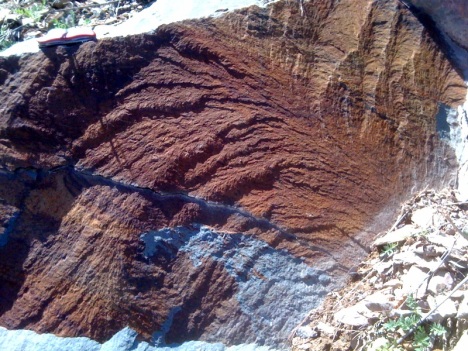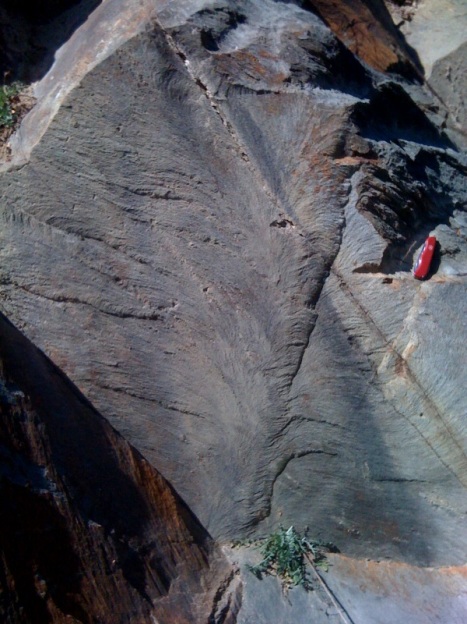…So where were we? Ahh, yes: an orogeny, and then some rifting. What happened next to Virginia and West Virginia? Let’s consult the column…

After the rifting event opened up the Iapetus Ocean, seafloor spreading took place and tacked fresh oceanic crust onto the margin of the ancestral North American continent. As North America (“Laurentia”) moved away from other continental fragments (Congo craton, Amazonia craton), it got a little bit calmer ’round these parts. From the continent’s perspective, the spreading center moving further and further offshore.
This shift of the tectonic locus out to the middle of an ocean basin means that the edge of the ancestral North American continent could finally relax a bit. The magmatic intrusions became a distant memory, and the crust cooled, contracted a bit, and sank. This subsidence allowed seawater to lap up onto the edge of the continent, and with the seawater came sediments. Rivers draining the exposed North American continent brought sediments to the sea, and dumped them. We geologists call this “passive margin sedimentation,” and it results in relatively “mature” sediments: those that have been well-worked over, typically rich in quartz and well sorted and with more rounded component grains.
As time went by, the edge of the continent subsided more and more, and any given spot in the modern-day Blue Ridge transitioned from streams to beach to continental shelf. The sedimentary stack reflects this increasing distance from the shoreline: a transgressive sequence.
It starts at the bottom with Weverton Formation: conglomerates and sandstones (and as I discovered on the Transect Trip, siltstones too). Here’s a piece of the Weverton from a GSW trip several springs ago:

The Weverton is overlain by muddy deposits of the Harpers Formation, which can also include coarse sandy units, as I learned on the Transect Trip. Here’s a shot of the Harpers Formation at Harpers Ferry, West Virginia, the type locality. This was taken five years ago, back when I had just gotten out of grad school, and spent a year teaching at George Mason University (pre-NOVA). [The student pictured is Steve Elmore, who just earned his master’s from GMU, working with Bob Hazen. Congratulations, Steve!]

The Harpers is really important, because it contains some Olenellus trilobite fossils, which constrain its age to be Cambrian.
The Harpers is overlain by another sandstone: a clean, pure quartz package named the Antietam Formation. For me, the Antietam is a favorite local rock, because it is studded with Cambrian-aged Skolithos trace fossils. On the trip, I used the iPhone to upload a few photos of these, but here’s a higher-resolution image to savor:

You’re looking at the bedding plane of the Antietam in the above image, with your sight-line parallel to the paleo-vertical orientation of the tubes. Wow. Beyond all reason or deeper interest, I just love Skolithos tubes. I look at this outcrop, and I wonder: is this a palimpsest? or a small wormy Manhattan? In other words: was this multitude of burrows generated by a small population that dug in the same area over a long period of time, or by a huge population living cheek-to-jowl over a relatively brief moment?
Regardless, the sand-then-mud-then-sand-again picture painted by the succession of Weverton-Harpers-Antietam isn’t a “textbook” transgressive sequence, but it might make more sense if you consider the Antietam sands as barrier island deposits, with the Harpers being deposited in a Pamlico-Sound-type setting.
Finally, the transgression is complete when we get to the top of the Blue Ridge sequence and see the Tomstown Formation, a carbonate unit:
 IMAGE CREDIT: USGS
IMAGE CREDIT: USGS
The Tomstown tells of a time when sea level had gotten so high locally that the shoreline was way, way, way far away. There were no clastic sediments making it out to this location, and all that was available to precipitate were the ions dissolved in the seawater. No sand, no pebbles, no mud: only carbonate.
The sequence of sedimentary strata continues, but to follow its succession upwards, you’ll have to travel across the Blue Ridge Thrust Fault to the west, into the Valley & Ridge province. More on that in the next post. For the moment, let me share a cartoon sequence of images by Tom Gathright (1976), showing the overall stratigraphic evolution of the Blue Ridge province*:

*Note that Gathright used the outmoded names “Hampton” instead of Harpers, and “Erwin” instead of Antietam. Please forgive him and move on.
That last panel, showing Alleghanian deformation, is something we will attack in a future post. For now, I’m satisfied to have finally climbed to the top of the Blue Ridge stratigraphic stack.
_________________________________________
Gathright, Thomas M., 1976. Geology of the Shenandoah National Park, Virginia. Virginia Division of Mineral Resources Bulletin 86, Charlottesville, VA. [buy it from SNPA Bookstore]
Filed under: blue ridge, cambrian, gsa, gsw, north america, ordovician, sediment, transect trip, virginia, west virginia | 2 Comments »

























 IMAGE CREDIT:
IMAGE CREDIT: 












